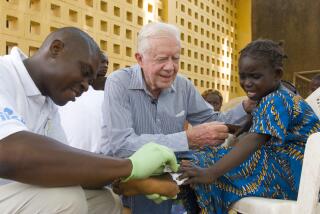Malaria’s Toll Fuels the Case for DDT Use in Africa
- Share via
NAIROBI, Kenya — DDT is making a comeback here.
Concerns over environmental damage led to a ban on the pesticide in the U.S. in 1972 and subsequently in many parts of the world, including in several African nations.
But now, some leaders in Kenya, Uganda and Tanzania say the chemical, whose full name is dichlorodiphenyltrichloroethane, is their last hope to stem an epidemic that kills 1 million Africans annually: malaria.
Although AIDS gets far more international attention, malaria is the No. 1 killer of African children, claiming one about every 30 seconds. And the toll is rising.
“DDT is the answer to our problems,” said Dr. John Rwakimari, head of the national malaria program in Uganda, where malaria rates over the last 15 years have increased fivefold. “We must do something.”
European Union officials recently warned Uganda it would be “taking a risk” if it reintroduced DDT spraying to eradicate mosquitoes. In Kenya, flower growers say Western supermarkets are wary of the chemical, putting the nation’s $400-million horticulture industry at risk. Kenya is the top supplier of fresh-cut flowers to the EU.
“All it will take is for one flower to test positive and there’s going to be a problem,” warned Jane Ngige, head of the Kenya Flower Council, the industry’s trade group.
African officials complain of hypocrisy and double standards on the part of Westerners, who used DDT to eradicate their own malaria problems decades ago but now push Africa to rely on harder-to-implement methods such as mosquito nets.
“The human cost of the Western policies is very high,” said economist James Shikwati, director of the Inter Region Economic Network in Nairobi. “A tiny insect, a mosquito, is wreaking havoc on Africans, but there is little they can do because they have to ensure that they do not lose their agricultural market in Europe.”
In addition to the human toll, Shikwati said malaria costs Africa $12 billion a year in lost gross national product and absorbs more than 20% of healthcare costs in some countries.
Ugandan President Yoweri Museveni said his country would proceed with DDT spraying, despite the EU warning.
“Why should we look on and watch our people die, when it is within our means to make a difference?” Museveni said during a speech on Africa Malaria Day in April.
The United States, where the international backlash against DDT started more than 40 years ago, has reevaluated its stance. The Bush administration said recently said that the Agency for International Development would provide money for spraying this year as part of its $99-million anti-malaria program.
DDT projects funded by USAID are expected to begin this year in Ethiopia, Zambia and Mozambique, said Richard Greene, director of the agency’s Office of Health, Infectious Diseases and Nutrition in Washington. Funding is also available to five other countries, including Kenya, Uganda and Tanzania, should those countries decide to deploy it, he said.
“Hundreds of thousands of lives can be saved, but you have to be very careful about how it’s used,” said Pam White, USAID director in Tanzania.
The Stockholm Convention, a global treaty signed in 2001, called for the eventual elimination of DDT worldwide, but it also permitted some countries to continue using the chemical under certain circumstances to combat malaria.
Several countries in Africa have deployed DDT-spraying programs in recent years that have yielded impressive results.
South Africa, which reintroduced DDT in 2003 after a seven-year ban, saw its malaria rates plummet 80%. Other nations experimenting with DDT include Eritrea, Zambia and Madagascar.
Environmentalists worry about the long-term effect.
“Bringing back DDT would be a disaster,” said Ahmed Hassanali, a department head at Kenya’s International Center of Insect Physiology and Ecology. “It’s taken the U.S. 30 years to recover from its widespread use.”
Studies suggest that DDT can seep into water and streams and remain in soil for up to 15 years. It has been detected in fish and birds, threatening the food chain. Many blame DDT use in the U.S. for the decline of bald eagles in the 1940s and 1950s.
DDT was developed into a pesticide during World War II by Swiss chemist Paul Hermann Mueller, who won a Nobel Prize for helping to save more than 500 million lives.
Whether DDT is harmful to humans is hotly debated, and there is no conclusive evidence on either side, experts say. Some studies suggest DDT can cause cancer in humans and interfere with female reproductive systems.
International backlash against DDT began in 1962 with the publication of Rachel Carson’s book “Silent Spring,” which focused attention on the environmental harm of man-made chemicals and helped spawn the environmental movement in the U.S.
Those in favor of using DDT to fight malaria in Africa insist that programs would be restricted and spraying would only be permitted indoors. One or two DDT treatments a year have been shown to be sufficient to kill malaria-carrying mosquitoes.
But critics say that once DDT is made readily available again, it will be difficult to monitor and regulate. Small farmers, in particular, will be tempted to use the pesticide on crops.
“It’s an issue of control,” Hassanali said. “We don’t have the infrastructure in Africa to handle this.”
More to Read
Sign up for Essential California
The most important California stories and recommendations in your inbox every morning.
You may occasionally receive promotional content from the Los Angeles Times.











